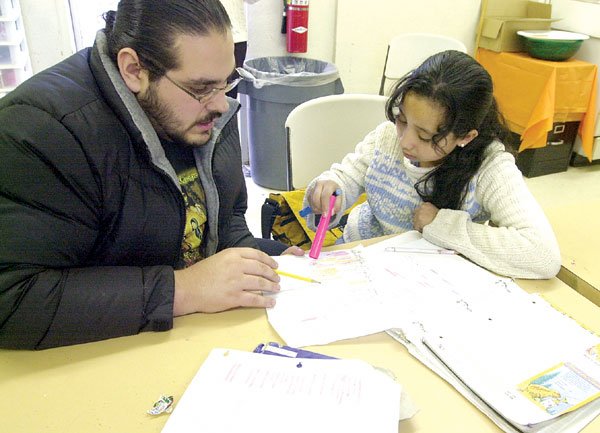GILROY
– There’s a particular boy Maria Elena de la Garza thinks of
when asked how the after-school program she runs helps steer kids
away from gangs.
GILROY – There’s a particular boy Maria Elena de la Garza thinks of when asked how the after-school program she runs helps steer kids away from gangs.
“He started coming here when he was 7,” de la Garza says. “He must be 12 or 13 by now. He comes here and talks about some of the influences he has at school, about wearing (gang) colors and doing some things that are not OK, and he comes here. He does his homework and takes advantage of the recreational programs.
“He comes here,” de la Garza reiterates.
“Here” is 7400 Railroad St., on the corner of Sixth Street. For the last 10 years, this former Pacific Gas & Electric warehouse, owned by the Gilroy Gang Task Force, has been home to the Mexican American Community Services Agency and Gilroy Community Youth Center, as well as an amateur boxing gym for older youth, run in part by the Police Activity League.
For about 50 kids a day, it’s the place to go after school. They go to MACSA first to do their homework, where tutors help them get through the more difficult problems, correct their mistakes and make sure they finish before they go over to the Youth Center. Some teachers even fax their assignments to MACSA so the tutors know exactly what their students assignments were. Despite its name, MACSA is open to all races. Staff and clientele are both Hispanic and Caucasian, and English, not Spanish, is the dominant language.
Unlike MACSA, the Youth Center is purely about recreation. There are pool tables, foosball, a basketball court, a television, a video game system and all kinds of special activities. On Wednesday and Thursday, staff organized a touch football tournament. Soon, they will begin painting a mural taking up the center’s entire south wall. They sometimes do arts and crafts. Every Friday is “Free Friday,” meaning that the center serves a full, free meal. Today’s fare is “monster tacos.”
The centers are open to children and young people from 6 years old to 18, and everything is free for the kids and their families (except candy kids can buy at the Youth Center). The Youth Center is a project of the city Community Services Department, funded by taxpayers. MACSA is a non-profit organization that works with both public funding and private donations. Both have paid staff, although they once scraped by with volunteers.
Oasis from gangs
The two agencies have been partners in this building since both opened a decade ago.
“Way back when, it all started with (former Gilroy mayor) Don Gage,” said de la Garza, the director for MACSA’s Gilroy programs. “He wanted to have a safe place for the students of this community.”
Those were the days of the founding of the Gilroy Gang Task Force, which hoped to reduce dangerous gang activity with a mixture of carrots and sticks. The main stick was the police department’s then-new Anti-Crime Team, a gang-specialty unit that now prides itself on knowledge of local gangsters, quick reaction time to disputes and monitoring of known gang members on parole or probation. The carrots were programs like the Youth Center that give positive alternatives to criminal behavior.
MACSA and the Youth Center pride themselves on being a safe oasis. “Very little” gang activity has ever infiltrated the centers, de la Garza said – even graffiti, the creators of which are often indiscriminate in their targets.
“We hardly ever get tagged,” de la Garza said. “And when it happens, two seconds later it’s reported to us. The kids tell us.”
School buses stop at 7400 Railroad St., and kids who attend nearby schools walk there. Homework time at MACSA begins at 2:30 p.m. (1:30 on Wednesdays), and the Youth Center opens at 3 p.m. It closes at 7, but staff will wait longer if a child’s parents or guardians have not picked them up by then.
MACSA’s after-school program is basically academic, but tutors like Norma Fonseca and Saul Gonzales also give the kids moral support while checking their math and English. On Thursday, Fonseca and Gonzales joked with second-grader Adrianna while checking her addition problems.
According to de la Garza, “providing positive adult relationships” is one way MACSA keeps kids away from drugs and violence.
“These adults are mentors … and role models to these kids,” de la Garza said. “Their faces light up when they see these (tutors).
“We have kids who are here Monday to Thursday (MACSA is closed on Friday) for hours every week. … I know they’re not out there (on the streets); they’re here.”
Homework, then hang out
But homework assistance is no small service by itself, especially since de la Garza says she’s seen kids’ homework load increase significantly in the last few years.
“We (now) have kids sometimes doing homework until 6:30,” she said.
Based on its students’ report cards, about 50 percent of MACSA’s kids have shown academic improvement since they started coming to MACSA and the Youth Center after school, de la Garza said.
At the Youth Center, staff member Tony Werner, 25 – a Gavilan College student who wants to become a sports coach some day – said most of the young people who attend come from low-income families. Some kids are sent there by working parents who don’t want them home alone, but many choose to come. They would show up on weekends, too, if it were open, Werner said.
“A lot of kids don’t have much,” Werner said. “They’d rather us be open seven days a week.”
The Youth Center does organize periodic outings on weekends. On Jan. 10, kids went to the East-West Shrine Game, a college football all-star event at SBC Park in San Francisco. Upcoming outings include a Feb. 7 trip to the Great Mall in Milpitas, several Gavilan College and Gilroy High School sports games and a San Francisco Giants baseball game in May.
MACSA, on top of its after-school program, has a wealth of support groups. It also offers community pride events and case management for young people at risk of criminal activity, and it runs a charter high school, El Portal Leadership Academy. MACSA is based in San Jose and has a second Gilroy location near San Ysidro Park. In a couple of years, it is expected to break ground for a new center on IOOF Avenue, to replace its Railroad Street location.
For more information, call MACSA at 847-4686 or the Gilroy Community Youth Center at 848-1675.













